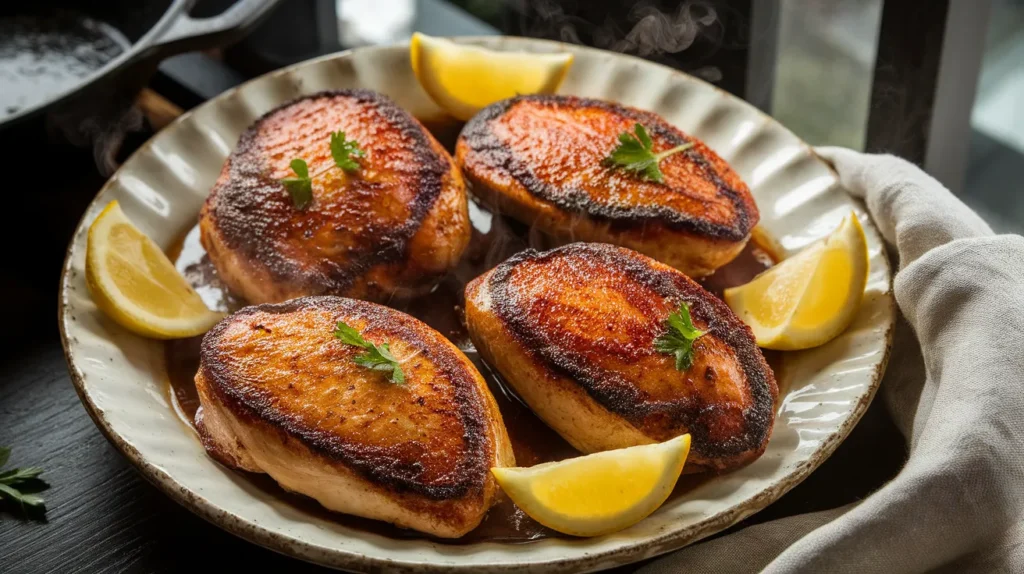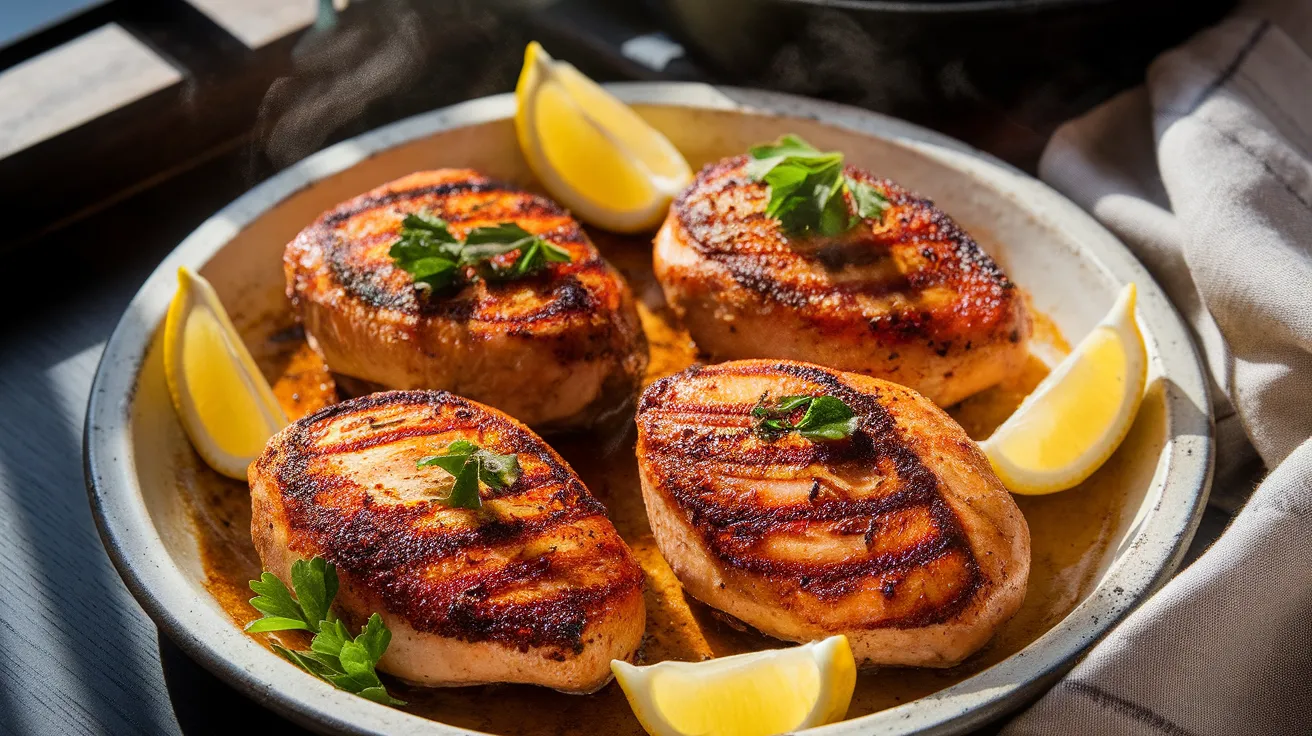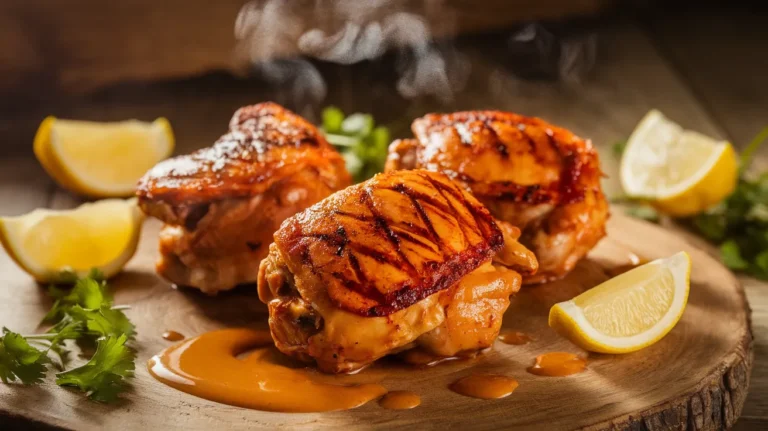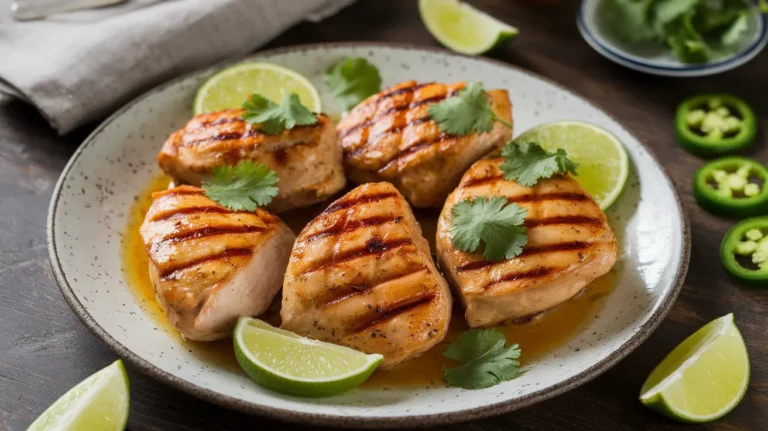This cajun marinated chicken transforms ordinary chicken breasts into a smoky, spicy masterpiece with just 10 minutes of prep. The bold blend of Cajun spices creates a caramelized crust that locks in moisture while delivering restaurant-quality flavor right from your home kitchen. Perfect for weeknight dinners when you want something special without the fuss.
SERVES: 4 | PREP: 15 MIN | COOK: 20 MIN | TOTAL: 35 MIN (plus 2-4 hours marinating)
Ingredients
For the Cajun Marinade
| Ingredient | Amount |
|---|---|
| Boneless, skinless chicken breasts | 4 pieces (about 6 oz each) |
| Olive oil | ¼ cup |
| Fresh lemon juice | 3 tablespoons |
| Garlic, minced | 4 cloves |
| Paprika | 2 tablespoons |
| Cayenne pepper | 1 teaspoon |
| Dried oregano | 1 tablespoon |
| Dried thyme | 1 tablespoon |
| Onion powder | 2 teaspoons |
| Black pepper, freshly ground | 1 teaspoon |
| Sea salt | 1½ teaspoons |
| Brown sugar | 1 tablespoon |
Optional Finishing Touches
| Ingredient | Amount |
|---|---|
| Unsalted butter | 2 tablespoons |
| Fresh parsley, chopped | 2 tablespoons |
| Lemon wedges | For serving |
Step-by-Step Instructions
Phase 1: Preparing the Chicken (5 minutes)
Step 1: Place your chicken breasts on a clean cutting board. Grab a sharp knife and trim away any excess fat or silver skin. Why this matters: Fat pockets can prevent the marinade from penetrating evenly, and silver skin gets chewy when cooked.
Step 2: Cover each chicken breast with plastic wrap. Using a meat mallet or the bottom of a heavy pan, gently pound the thicker parts until the entire breast is about ¾-inch thick throughout. The goal here: Even thickness means even cooking—no more dry edges and raw centers.
Step 3: Use a fork to poke 8-10 shallow holes across each chicken breast. Don’t stab all the way through; just create tiny channels on the surface. This step is crucial because it lets the cajun marinated chicken absorb way more flavor during the marinating process.
Phase 2: Creating the Marinade (5 minutes)
Step 4: In a medium mixing bowl, combine the paprika, cayenne pepper, oregano, thyme, onion powder, black pepper, salt, and brown sugar. Whisk these dry spices together for 30 seconds. Watch for: The mixture should be uniform in color with no clumps.
Step 5: Add the olive oil, lemon juice, and minced garlic to your spice mixture. Whisk vigorously for about a minute until everything emulsifies into a thick, reddish-orange paste. You’ll know it’s ready when the oil is no longer separating and the mixture clings to your whisk.
Step 6: Taste your marinade carefully with a clean spoon. Safety tip: Never put the spoon back in after tasting! The balance should be smoky-sweet with a kick of heat. If it’s too spicy for your preference, add another ½ tablespoon of brown sugar to mellow it out.
Phase 3: Marinating (2-4 hours, mostly hands-off)
Step 7: Place your prepared chicken breasts in a gallon-sized zip-top bag or a shallow glass dish. Pro insight: Glass or plastic only—metal can react with the acidic lemon juice and create off-flavors.
Step 8: Pour the marinade over the chicken, making sure every piece gets coated. Massage the bag gently for about 30 seconds, working the marinade into all those little holes you poked earlier. Visual cue: Each piece should be completely covered in a thick, red coating.
Step 9: Seal the bag (or cover the dish with plastic wrap) and refrigerate for at least 2 hours, up to 4 hours maximum. Flip the bag every hour if you remember. Important timing note: Don’t marinate longer than 4 hours—the lemon juice will start breaking down the protein too much and make the texture mushy.
Phase 4: Cooking the Perfect Cajun Chicken (20 minutes)
Step 10: Remove the chicken from the refrigerator 20 minutes before cooking. Let it sit on the counter to take the chill off. Why this step matters: Cold chicken hitting a hot pan causes uneven cooking and that rubbery texture nobody wants.
Step 11: Preheat your heaviest skillet (cast iron is ideal) over medium-high heat for 3-4 minutes. Temperature check: Flick a drop of water onto the pan—it should sizzle and evaporate immediately. Add 1 tablespoon of oil and swirl to coat.
Step 12: Remove the chicken from the marinade, letting excess drip off. Don’t wipe the chicken clean—you want that flavorful coating to stay on. Place each piece in the hot skillet with at least 1 inch of space between them.
Step 13: Let the chicken cook undisturbed for 6-7 minutes. Resist the urge to move it! You’re building that beautiful caramelized crust. Look for: The edges should turn opaque about halfway up the side, and you’ll smell an amazing smoky-sweet aroma.
Step 14: Flip each piece carefully with tongs. The bottom should be deep golden-brown with dark spice-crusted edges. Cook for another 6-7 minutes. Temperature target: Insert an instant-read thermometer into the thickest part—you’re aiming for exactly 165°F.
Step 15: During the last minute of cooking, add the butter to the pan around the chicken. As it melts, tilt the pan and spoon the buttery juices over each piece 3-4 times. This basting step adds richness and creates a glossy finish.
Step 16: Transfer the cajun marinated chicken to a clean plate and tent loosely with foil. Let it rest for 5 full minutes. Critical step: The juices need time to redistribute—cut too early and they’ll all run out onto your plate instead of staying in the meat.
Step 17: Garnish with fresh parsley and serve with lemon wedges on the side. That final squeeze of fresh lemon brightens all those deep, smoky flavors.
Chef’s Notes
Spice Level Control: This cajun marinated chicken packs moderate heat. For mild, reduce cayenne to ½ teaspoon. For extra fire, bump it up to 1½ teaspoons or add a pinch of white pepper.
The Brown Sugar Secret: Don’t skip this ingredient! It balances the heat, helps create that gorgeous caramelized crust, and prevents the spices from tasting harsh or one-dimensional.
Marinade Timing Sweet Spot: Two hours is the minimum for decent flavor penetration. Four hours is perfect. Go beyond four and the lemon juice starts “cooking” the chicken, making it mushy.
Skillet Selection Matters: Cast iron retains heat better than stainless steel, which means better browning and crust formation. If using stainless, you might need an extra minute per side.
Nutrition Facts (Per Serving)
Calories: 285 | Protein: 38g | Carbs: 8g | Fat: 11g | Fiber: 1g | Sodium: 680mg
Creative Variations to Try
1. Cajun Marinated Chicken Pasta Bowl
Slice your cooked chicken and toss it with penne, cherry tomatoes, and a cream sauce spiked with extra Cajun seasoning. The smoky chicken flavors blend beautifully with pasta—almost as amazing as this chipotle lime chicken over rice.
2. Smoky Chicken Tacos
Dice the cooked chicken and pile it into warm tortillas with shredded cabbage, avocado, and lime crema. The Cajun spices create a completely different vibe from traditional taco proteins.
3. Meal Prep Power Bowls
Slice the chicken and arrange it over quinoa with roasted sweet potatoes, sautéed peppers, and a drizzle of ranch. Make four containers on Sunday and you’re set for the week.
4. Cajun Chicken Salad Supreme
Chop the cooled chicken and mix it with Greek yogurt, celery, red onion, and a touch of the leftover spice blend. Serve on croissants or lettuce cups. For another incredible chicken salad base, try this tequila lime chicken version—the citrus notes are unreal.
Storage & Reheating
Refrigerator Storage: Place cooled chicken in an airtight container with a paper towel on top to absorb excess moisture. Keeps for 4 days maximum.
Freezer Storage: Wrap each piece individually in plastic wrap, then place all pieces in a freezer bag. Label with the date. Frozen cajun marinated chicken stays good for up to 3 months.
Reheating from Refrigerator: Microwave on 50% power in 30-second intervals, or reheat in a 325°F oven for 10-12 minutes until warmed through. Add a tablespoon of water or chicken broth to prevent drying out.
Reheating from Frozen: Thaw overnight in the refrigerator first, then follow the reheating instructions above. Never microwave from frozen—you’ll end up with rubbery edges and a cold center.
Make-Ahead Strategy: Prepare the marinade up to 3 days in advance and store it separately in the fridge. Add the chicken when you’re ready to start marinating.

Troubleshooting Common Problems
Problem 1: Chicken Is Dry and Overcooked
Solution: Your pan was too hot, or you cooked past 165°F. Invest in an instant-read thermometer—they cost $15 and solve this problem forever. Remember, chicken continues cooking for a few degrees during the resting period.
Problem 2: Spices Are Burning Before Chicken Cooks Through
Solution: Lower your heat to medium instead of medium-high. The sugars in the marinade can scorch quickly. If you notice blackening within 3 minutes, immediately reduce the heat and add a splash of water to the pan.
Problem 3: Marinade Isn’t Sticking to the Chicken
Solution: Your chicken was too wet when you added it to the marinade. Pat it completely dry with paper towels before marinating. Also, make sure you’re massaging the marinade in thoroughly and using those fork holes to help it penetrate.
Problem 4: Chicken Tastes Bland Despite Marinating
Solution: You either didn’t marinate long enough (minimum 2 hours) or your spices were old and had lost their potency. Check expiration dates—ground spices lose flavor after 6 months. Also, make sure you’re salting adequately; salt is what makes all the other flavors pop.
Problem 5: Outside Is Perfect But Inside Is Still Pink
Solution: Your chicken breasts were too thick or you started with cold chicken. Always pound to even thickness and let sit at room temperature for 20 minutes before cooking. If this keeps happening, finish thick pieces in a 375°F oven for 5-7 minutes after searing.
Equipment Essentials
- Heavy-bottomed skillet (cast iron preferred, 12-inch)
- Instant-read meat thermometer (accuracy to 1°F)
- Meat mallet or rolling pin (for pounding)
- Gallon zip-top bags or shallow glass dish (for marinating)
- Mixing bowls (medium size)
- Whisk
- Sharp chef’s knife
- Cutting board (plastic for raw chicken)
- Kitchen tongs
- Aluminum foil (for resting)
Shopping List by Store Section
Meat Department:
- 4 boneless, skinless chicken breasts (6 oz each)
Produce Section:
- 1 lemon
- 1 head of garlic
- Fresh parsley (1 small bunch)
Spice Aisle:
- Paprika
- Cayenne pepper
- Dried oregano
- Dried thyme
- Onion powder
- Black peppercorns (if you don’t have a grinder at home)
Baking Aisle:
- Brown sugar
Oils & Vinegars:
- Olive oil
Dairy (optional finishing):
- Unsalted butter
Pantry Staples You Probably Have:
- Sea salt or kosher salt
Success Secrets from the Test Kitchen
1. The Double-Rest Technique: Let chicken rest both before AND after cooking. Twenty minutes at room temp before cooking, and 5 minutes tented after. This simple habit is the difference between juicy and dry.
2. Save That Marinade (Safely): Reserve ¼ cup of marinade before adding raw chicken. Boil it for 3 minutes on the stove, then brush it on the finished chicken for an extra flavor boost. Never use uncooked marinade that touched raw chicken.
3. The Finger Test for Doneness: While a thermometer is best, experienced cooks can press the chicken gently. If it feels like the fleshy part of your palm below your thumb (when your thumb touches your ring finger), it’s done. Mushy means undercooked, rock-hard means overcooked.
4. Flip Only Once: Multiple flipping prevents proper crust formation. Put it in the pan, leave it alone for 6-7 minutes, flip once, leave it alone again. Patience creates that restaurant-quality crust on your cajun marinated chicken.
5. Clean Your Workspace Constantly: Raw chicken cross-contamination is serious. After handling raw chicken, immediately wash your hands, knife, cutting board, and any surfaces it touched with hot, soapy water before touching anything else. Keep a spray bottle of diluted bleach solution (1 tablespoon bleach per quart of water) nearby for sanitizing.




